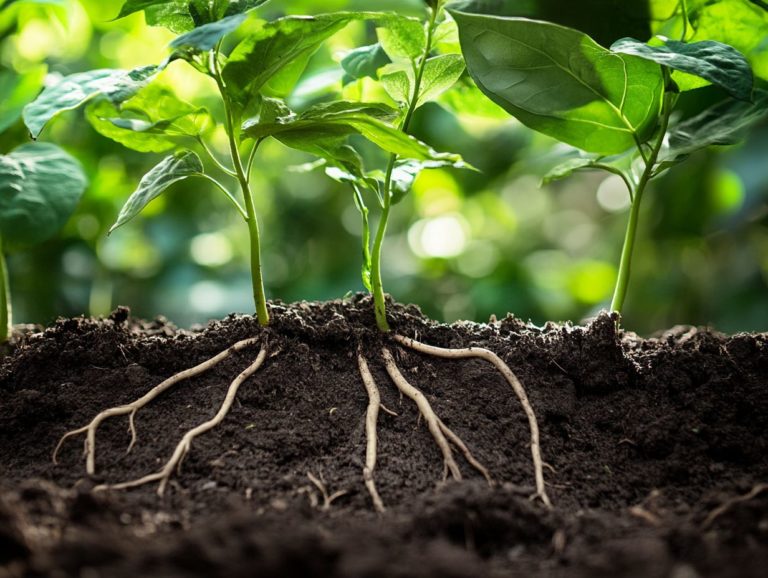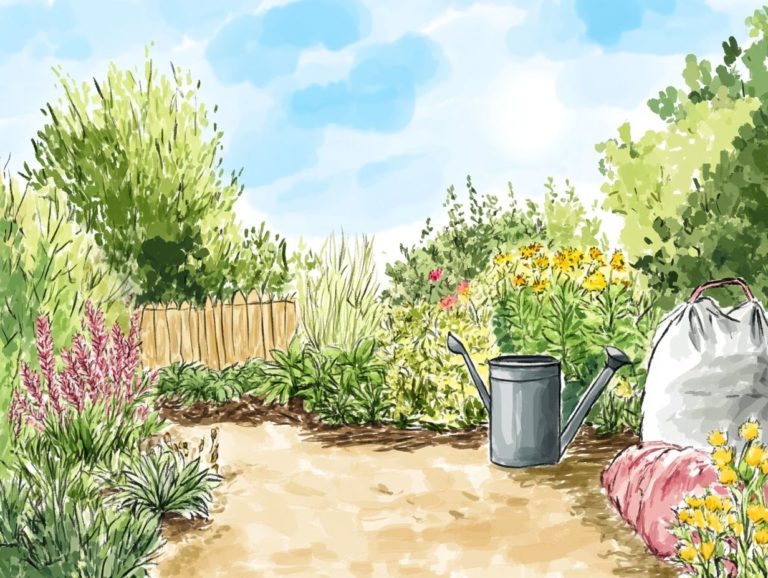The Role of Shade in Drought Gardening
In a time when water conservation is paramount, drought gardening stands out as a sustainable option for gardening enthusiasts like you. Methods like Low-Water Shade Gardening can make a significant difference.
This article delves into the importance of incorporating shade into your gardening practices. It emphasizes its vital role in water conservation and supports plant resilience, particularly in dry shade areas.
Uncover the advantages of different shade structures and familiarize yourself with drought-tolerant plants. Explore effective companion planting strategies to enhance your garden’s potential.
You ll receive practical tips for implementing shade and other water-saving techniques. These will enable you to cultivate a thriving garden that flourishes even in arid conditions.
Contents
- Key Takeaways:
- The Importance of Drought Gardening
- How Shade Can Help in Drought Gardening
- Choosing the Right Plants for Shade in Drought Gardening
- Implementing Shade in Your Drought Garden
- Other Techniques for Water Conservation in Drought Gardening
- Frequently Asked Questions
- What is the role of shade in drought gardening?
- How does shade benefit plants in drought gardening?
- Can all plants thrive in shade during drought gardening?
- How can I incorporate shade into my drought gardening strategy?
- Is it possible to have a garden with only shade-loving plants in a drought-prone area?
- How Can I Ensure My Plants Are Getting Enough Shade in a Drought Garden?
Key Takeaways:

- Sustainable gardening practices are crucial in combating drought and preserving resources.
- Shade structures and well-chosen plants significantly aid in water conservation in drought gardening.
- You can optimize water usage by properly placing and maintaining shade in your drought garden, along with techniques like rainwater harvesting and mulching.
The Importance of Drought Gardening
Drought gardening is vital for tackling climate change challenges. It is especially important in urban parks where limited sunlight and fierce competition for water hinder traditional gardening.
By embracing sustainable gardening techniques like Low-Water Shade Gardening, you enhance soil quality and moisture retention. This thoughtful approach saves water and boosts the variety of plant life in your garden, making it a vibrant space!
Understanding the Need for Sustainable Gardening Methods
Sustainable gardening methods are essential for navigating environmental challenges like droughts and limited sunlight, giving you the power to develop effective dry shade gardening strategies.
Incorporating techniques such as composting and mulching enhances soil quality and improves organic matter. These practices are key in mitigating the negative impacts of reduced sunlight and low moisture, fostering resilience in shade gardens.
This adaptability enables a diverse array of plants to flourish even in less-than-ideal lighting conditions. It ultimately creates a vibrant habitat that supports various forms of life.
Act now to embrace sustainable gardening practices that benefit both your garden and the planet! This ensures that natural resources are preserved for future generations.
How Shade Can Help in Drought Gardening
Shade serves a crucial function in drought gardening. It provides vital protection for plants in dry, shaded areas, where using cover crops in drought gardening can help retain moisture essential for their survival and growth.
In such environments, understanding the interplay of light and moisture can make all the difference in cultivating a thriving garden.
Benefits of Shade in Conserving Water
The benefits of shade in conserving water are numerous, especially when you re dealing with gardening challenges where keeping moisture is key. Shade minimizes water loss by significantly lowering evaporation rates.
This natural barrier helps preserve soil moisture, ensuring your plants have the water they need to thrive. It also helps maintain consistent soil temperatures, creating an environment less prone to extremes of heat and cold.
With stabilized temperatures, your plants experience less stress, positively impacting their overall health and vitality. This stability enhances nutrient availability in the soil, creating a more efficient garden ecosystem that ultimately supports sustainable gardening practices.
Types of Shade Structures

Imagine elegant pergolas that create beautiful, relaxing spaces! You can implement various types of shade structures in urban parks and private gardens to elevate your dry shade gardening while ensuring optimal moisture retention for your plants.
Consider versatile shade sails that can be customized to fit your unique garden layout. These installations not only enhance the visual appeal of your environment but also serve practical purposes.
When strategically utilized, tree canopies provide natural shade that fosters an ecosystem conducive to plant growth in drier conditions. By employing such structures, you can significantly boost the adaptability of specific plant species, allowing them to flourish in areas with limited sunlight and contributing to healthier, more resilient gardens.
Each shade solution comes with its own set of benefits. This makes it easier for you to design spaces that satisfy both your visual preferences and functional requirements.
Choosing the Right Plants for Shade in Drought Gardening
Choosing the right plants is essential in drought gardening, especially when it comes to selecting drought-tolerant varieties that flourish in shade and enhance soil organic matter. Choose the right plants to support a resilient garden and create a thriving ecosystem below the surface.
Drought-Tolerant Plant Varieties
Drought-tolerant plant varieties, like perennials and shrubs, are your go-to choices for shade gardens. They combine resilience with beauty even in challenging conditions.
Plants such as Acanthus mollis, Heuchera maxima, and Hakonechloa macra thrive under trees and in poor soil. This ensures that the shadier corners of your yard remain visually captivating.
Acanthus mollis, renowned for its bold leaves and architectural form, creates a striking backdrop. Meanwhile, Heuchera maxima dazzles with its colorful foliage, injecting vibrant hues into your landscape.
Hakonechloa macra brings a soft, flowing elegance that makes it a preferred option for ground cover. The adaptability of these varieties not only enhances the aesthetics of your garden but also promotes sustainable practices, requiring less water and maintenance.
This way, you can revel in lush greenery without the constant care.
Companion Planting Strategies
Companion planting strategies allow you to optimize your gardening space and resources. Pairing compatible plants tackles challenges and enriches the organic matter in your soil.
By thoughtfully selecting which plants to pair, you can cultivate beneficial plant pairings that not only thrive in drought conditions but also enhance the overall vitality of your garden. For example, when you combine legumes with root vegetables, you help fix nitrogen in the soil, boosting nutrient availability for your other plants.
Similarly, pairing marigolds with tomatoes acts as a natural deterrent for harmful pests, cutting down the need for chemical interventions.
These strategies enhance plant partnerships and play a crucial role in improving soil quality and moisture retention. Diverse root systems work together to maintain moisture levels and prevent erosion.
Ultimately, employing such methods fosters resilience, making your garden more adaptable to the unpredictable challenges of climate variability.
Implementing Shade in Your Drought Garden
To implement shade effectively in your drought garden, you need to grasp the nuances of proper placement while committing to regular maintenance. This includes essential tasks like pruning and thinning, which not only promote healthy growth but also optimize resource management.
Start planning your shade garden today for a dramatic transformation!
Tips for Proper Placement and Maintenance

The proper placement and maintenance of plants in your drought garden are essential for their survival. You ll want to focus on practices like applying mulch and utilizing efficient watering techniques.
To optimize shade and moisture retention, take a moment to consider the orientation of your garden beds in relation to sun exposure and wind patterns. Grouping drought-tolerant plants together not only creates a beneficial microclimate but also promotes a healthier growing environment.
Using organic mulch, such as wood chips or straw, will help insulate the soil, retain moisture, and suppress pesky weeds. Adopting deep watering techniques like using drip irrigation (which delivers water directly to the roots of plants, making it very efficient) encourages roots to delve deeper, enhancing your plants’ resilience during dry spells.
Regular maintenance through careful observation ensures timely interventions, keeping your garden ecosystem robust and sustainable.
Other Techniques for Water Conservation in Drought Gardening
Along with choosing the right plants, you can use helpful methods to save water in drought gardening. Start harvesting rainwater today to help your garden flourish, and utilize effective mulching strategies, both of which can significantly enhance moisture retention in your garden.
Rainwater Harvesting and Mulching
Rainwater harvesting and mulching are essential in drought gardening, particularly in urban parks where moisture retention is crucial for plant survival.
By capturing and storing rainwater, you can ensure that your plants have access to vital hydration during dry spells, significantly reducing your reliance on municipal water sources. Mulching acts as an effective barrier, minimizing soil evaporation and maintaining moisture levels even during the hottest summers.
These amazing techniques save water and help your plants thrive! When you implement rainwater harvesting systems alongside mulching, you create a sustainable ecosystem that fosters biodiversity while offering visitors a vibrant and lush green space to enjoy. Such practices bolster the resilience of urban parks, transforming them into not just functional spaces but environmentally friendly sanctuaries.
Frequently Asked Questions
What is the role of shade in drought gardening?
The role of shade in drought gardening is to protect plants from direct sunlight, which can quickly dry out the soil and cause water stress. Additionally, understanding the role of mulch in drought gardening can further help keep the soil and plants cooler, reducing water evaporation and aiding in moisture retention.
How does shade benefit plants in drought gardening?

Shade provides a temporary respite for plants during hot, dry periods. It helps reduce water loss from leaves and conserves moisture in the soil, keeping plants hydrated and healthy during times of drought.
Can all plants thrive in shade during drought gardening?
Not every plant grows well in shade during dry spells. Some plants, such as succulents and cacti, are adapted to handle periods of drought and may not need as much shade. However, most plants will benefit from some shade during hot and dry conditions.
How can I incorporate shade into my drought gardening strategy?
You can incorporate shade into your drought gardening strategy by using natural or artificial shade structures, such as trees, shrubs, pergolas, or shade cloth. You can also strategically plant taller plants to provide shade for shorter ones.
Is it possible to have a garden with only shade-loving plants in a drought-prone area?
It is possible to have a garden with only shade-loving plants in a drought-prone area, but it may require more careful planning and maintenance. You may need to choose plants that are more drought-tolerant and can thrive in shady conditions.
How Can I Ensure My Plants Are Getting Enough Shade in a Drought Garden?
Keep your plants happy by ensuring they get enough shade during dry spells! Monitor the direct sunlight they receive throughout the day.
Use a light meter or a simple hand test to check the shade level in different areas. If needed, create extra shade with structures or by moving plants to shadier spots.






